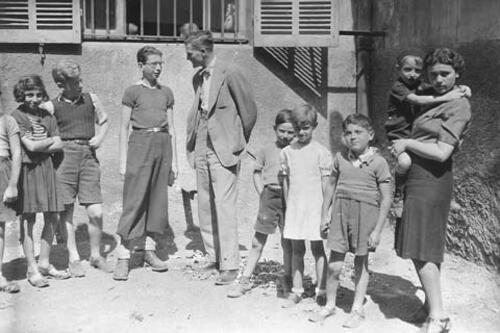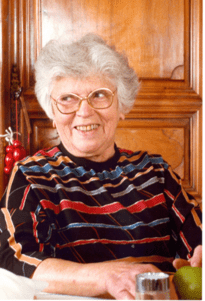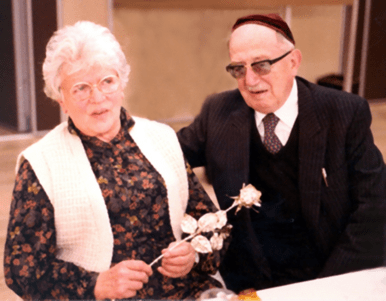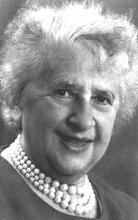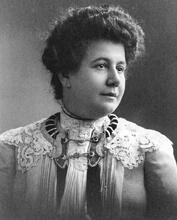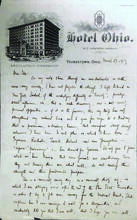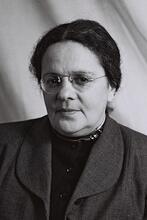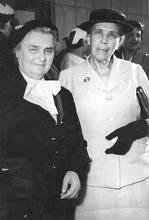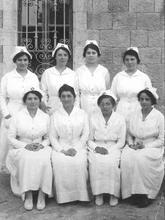Andrée Salomon
Andrée Salomon was responsible for saving approximately 1,000 Jewish children during the German Occupation of France between 1940 and 1944. After Hitler seized power in Germany in 1933, she became a member of a Jewish organization helping German Jewish refugees and facilitated illegal immigration to Palestine. After the outbreak of war, she served as head of the social services department of the Oeuvre de Secours aux Enfants (Association for Assistance to Children) and the OSE representative in the Gurs and Rivsealtes internment camps, where children and adults lived in terrible conditions. After the arrest of approximately 10,000 Jews in France in 1942, she helped to smuggle many children out of France. Later in life, she moved to Israel, where she died in 1985.
Andrée Salomon, a heroine of the French Jewish Resistance, saved approximately 1,000 Jewish children during the Germany Occupation of 1940-1944. She secured the release of the children, who had been interned in dreadful concentration camps in the south of France, and sent them to children’s homes run by the Oeuvre de Secours aux Enfants (Society for Assistance to Children), a Jewish health organization. Salomon directed an underground network that hid the children under fake identities with non-Jewish families and organized clandestine crossings of the Swiss and Spanish borders. She was an active militant in Zionist organizations, especially facilitating clandestine immigration to Mandate Palestine, and in the Women’s International Zionist Organization.
Early Life & Family
Andrée Salomon was born on May 25, 1908, in the village of Grussenheim, France, the third of seven children of an Ashkenazi Jewish family that had lived in the province of Alsace since the 17th century. Her father, Jonas Sulzer, and her mother, Marie Geismar, owned the town’s Jewish butchery.
After secondary school, Salomon started working in Strasbourg, the capital of Alsace, for the lawyer Jacques Fonlupt, who became a Gaullist deputy after the war. With friends, she founded the Eclaireurs et Eclaireuses israélites de France, a scouting organization for Jewish youth. She also joined the Zionist movement Hatikvah, where she met Tobie Salomon, a brilliant petroleum engineer whom she married in 1931. She also joined the Gdoud Haovdoth le-Erez Israël, a Zionist women’s association, and became its representative to the Jewish Agency’s Palestine Office.
Work with German Jewish Refugees
In 1933, after Hitler seized power in Germany, Salomon became a member of a Jewish organization helping German Jewish refugees; she was in charge of immigration to Palestine. In cooperation with HeHaluz (The Pioneer), a Zionist movement that trained young people in agriculture, she established training centers in Alsace and Luxembourg. The pioneers were then sent to Mandate Palestine, either through the official channel of the Palestine Office or the illegal network of the Mossad Le’alyiah Bet (Institution for Immigration B). Andrée and Tobie Salomon visited Erez Israel in 1934, 1937, and 1938. Among others, they met Henrietta Szold (1860-1945), director of the Aliaht Hanoar (Youth Aliyah). Andrée Salomon returned alone in 1946 and several times thereafter, to meet her protegés working in the kibbuzim.
After the Kristallnacht pogrom of November 9-10, 1938, in which the Nazis looted Jewish shops, set fire to synagogues, killed 2,000 Jews, and arrested 55,000, Salomon participated in a committee that hosted in Alsace 52 German boys and girls from Frankfurt-am-Main. She clashed several times with the German police when she searched for the children at the Kehl railway station on the German border near Strasbourg. Some children still had glass debris from broken windows on their clothes.
Outbreak of War
In September 1939, after the declaration of war between France and Germany, Salomon brought 30 of these children to a mountain chalet in south Alsace. In May 1940, she left in a hurry when the Germans invaded France. She joined her husband in Clermont-Ferrand, in the center of France, and sent the children to several homes opened in various towns by the Oeuvre de Secours aux Enfants (OSE), a Jewish health organization founded in Russia in 1912 and operating in France since 1934. (One of the boys, Ernest Stock, later published a book describing his life in Frankfurt under Nazi rule and his escape, with his sister Lotte, from Paris to Lisbon, where they stowed away on an American cargo ship before being triumphantly greeted in New York.)
Appointed head of OSE’s social services department, Salomon participated with Dr. Joseph Weill (1902-1988), an Alsatian member of the Jewish Resistance, in the so-called Comité de Nîmes, which brought together over 30 French and foreign charitable associations to help Jewish families driven out of Germany by the Nazis and interned in concentration camps in the south of France by the French government. The committee included the American Quakers, the Unitarian Service Committee, the World YMCA and YWCA, the Swiss Red Cross, the Hebrew Immigrant Society, the American Jewish Joint Distribution Committee, ORT, and the main French Catholic, Protestant, and Jewish assistance institutions.
Salomon also became the OSE representative in the Gurs and Rivesaltes internment camps near the Spanish border, where about 6,000 people lived on straw in unheated wooden huts, without running water and teeming with mud and vermin. She recruited young girls as volunteer assistants to live in the camps with the internees and provide them with food, clothes, drugs, and moral support. She negotiated with the authorities to allow the sick and elderly to leave the camps temporarily and obtained housing certificates to place about 1,200 children into OSE homes or foster families. And she prepared immigration files for about 300 children authorized to go to the United States. All the adults and children who remained in the camps were deported, first to Drancy, a concentration camp near Paris, then to Auschwitz.
Smuggling Children Out
In 1942, after the arrest of about 20,000 Jews in France, OSE leaders understood that the children’s homes had become death traps. They decided to hide the children under false identities in non-Jewish families or institutions, with the help of Catholic and Protestant associations. Fluent in Yiddish, German, and French, Andrée Salomon became the official representative of a Catholic health association for young mothers. She refused to give the children’s new addresses to the French authorities.
Together with engineer Georges Garel (1909-1979), Salomon created a double network named A and B, which controlled all of the rescue operations, from making false papers through payment for housing (a duty towards the foster parents she considered a sacred mission), including contact with Catholic bishops and Protestant notables, the search for hiding places, and recruiting non-Jewish girls to guide the children during the trips. Several members of the network were murdered by the Germans. An escape route built by Georges Loinger (1910-2017) allowed more than 1,000 children to cross the Swiss border illegally. Another network permitted about a dozen young people to cross the Spanish border on foot through the Pyrenees to Cadix, where they boarded a Portuguese boat to Palestine. The rescues were financed through gold coins provided by the American Joint Distribution Committee in Switzerland, directed by Sally Mayer, which were transferred to France by local smugglers. During this period, Andrée Salomon made countless trips between her secret hiding place, the various OSE offices, the children’s homes, and houses where the children boarded. She often travelled by night, sleeping in cafés, railways station waiting rooms, or hotels. Always smiling, always knowing how to deal with all situations, Andrée Salomon was adored by all children and parents for her courage, energy, generosity, and simplicity.
After the Liberation
In 1944, after the Liberation of France, Salomon went to Paris and helped to open new OSE homes in several French provinces. She directed research on the hidden children, who had to rediscover their Jewish identities. With Jacques Cohn (1916-1974), a scholar who later became an educational inspector in Israel, she created a method to help child victims of war readapt to normal life, based on respect for their emotional awareness and religious sensibilities. She also called for extensive training of educators.
In 1947, Salomon resigned from OSE but remained on its board of directors. She returned to Strasbourg, where she gave birth to her son Jean in 1948. In 1951, the family moved to Paris, where Salomon became manager of communications in the State of Israel Bonds, an investment agency. She also worked intensively as a deputy general secretary of French WIZO. In 1970, the family moved to Omer, a new town near Beersheva in Israel. Their house on the edge of the Negev desert soon became a meeting place for former Alsatian scouts, fighting comrades, and children from everywhere in the world.
Legacy
Andrée and Tobie Salomon were a gracious couple, offering help and giving advice to all visitors. They accepted neither honors nor rewards. During the war, they refused to go to the United States with emergency visas from the Emergency Rescue Committee or to take refuge in Switzerland. They accepted only counterfeit certificates to become citizens of the San Salvador Republic, a fragile protection against the French and the German secret police.
An inscription at the Jewish cemetery of Grussenheim and a commemorative panel near a former OSE nursery near the port of Sète in the south of France recall Salomon’s actions in saving children during the Second World War. At the Yad Vashem Museum in Jerusalem, her portrait with the German children in Alsace symbolizes the work of the entire French Jewish Resistance to the Vichy government and the Gestapo. OSE’s socio-educational center in Paris and the French-speaking WIZO section in Jerusalem bear the name of Andrée Salomon.
Andrée Salomon died and was buried in Jerusalem in 1985.
L’OSE sous l’occupation en France. 1940-1944, Paris-Genève: CDJC, 1947. Reed. 1983. Final annotated version: Garel, Georges. Le sauvetage des enfants juifs par l’OSE. With the assistance of Katy Hazan. Paris: Fondation pour la Mémoire de la Shoah-Le Manuscrit, 2012.
Weill, Dr Joseph. Contribution à l’histoire des camps d’internement dans l’anti-France. Paris : CDJC, 1946.
Weill, Georges and Hazan, Katy. Andrée Salomon, Une femme de lumière. Paris: Fondation pour la Mémoire de la Shoah-Le Manuscrit, 2011.
Weill, Georges. “Andrée Salomon et le sauvetage des enfants de France (1933-1947).” French Politics, Culture & Society 30, 2 (Summer 2012): 89-112.
Weill, Georges. “The OSE and the Rescue of Jewish Children, from the Post-War to the Pre-War Period.” In Resisting Genocide. The Multiple Forms of Rescue, edited by Jacques Semelin, Claire Andrieu and Sara Gensburger. Translated by Emma Bentley and Cynthia Schoch. London: Hurst & Cy, 2011: 245-263.
For further research:
Boitel, Anne. Le camp de Rivesaltes, 1941-1942 : du centre d'heb́ergement au "Drancy de la zone libre.” Perpignan: Presses universitaires de Perpignan, 2001.
Grynberg, Anne. Les camps de la Honte. Les internés juifs des camps français, 1939-1944. Paris: La Découverte, 1991.
Laharie, Claude. Le Camp de Gurs. 1939-1945. Un aspect méconnu de l'histoire du Béarn. Pau : Infocompo, 1985.
Loinger, Georges, and Frida Xattenberg. Organisations juives de combat: Résistance/Sauvetage. France 1940-1945. Paris: Editions Autrement, 2002.
Samuel, Vivette. Sauver les Enfants. Paris: Liana Levi, 1995.
Stock, Ernest. Tri-Continental Jew: A 20th Century Journey. Middleton, DE: Mendele Electronic Books Ltd, 2015.
Weill, Dr Joseph. Le Combat d'un Juste. Saumur: Éditions Cheminements, 2002.






